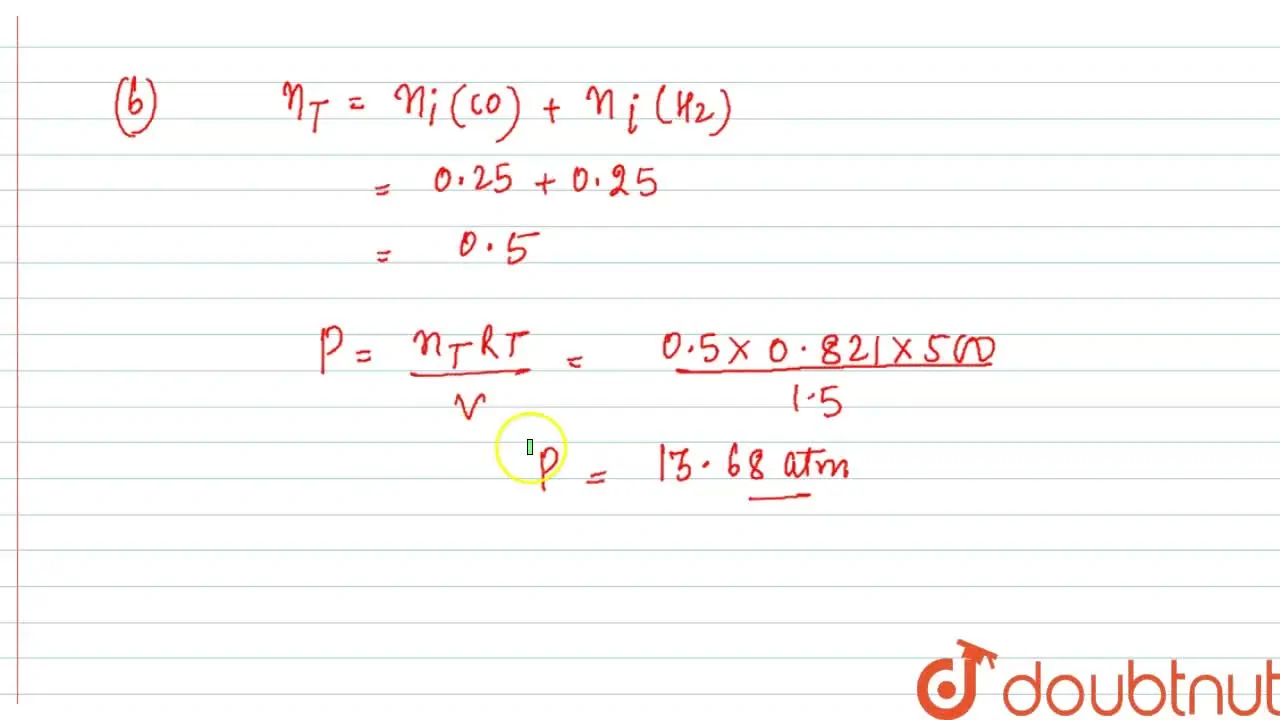0.25 mol of CO taken in a 1.5L flask is maintained at 500K along with a catalyst so that the following reaction can take place:
CO(g)+H2(g)⇔CH3OH(g) .
Hydrogen is introduced until the total pressure of system is 8.2atm, at equilibrium, and 0.1mol of methanol is formed. Calculate
a. Kp and Kc
b. The final pressure if the same amount of CO and H2 as before are used but no catalyst so that the reaction does take place.
First balance the equation as:
CO(g)+2H2(g)⇔CH3OH(g)
Kc=[CH3OH][CO][H2]2
Let y moles of H2 were present initially.

x=0.10 (given)
⇒ moles of CO=0.25−0.10=0.15,
moles of H2=y−0.2 and
moles of CH3OH=0.10
⇒ Total moles =nT=0.15+(y−0.2)+0.10=0.05+y
Equilibrium pressure (P)=8.2atm
Volume of vessel (V)=1.5L,T=500K
Using the gas equation, PV=nRT, we have
nT=PVRT=8.2×1.50.0821×500=0.3
⇒0.30=0.05+y⇒y=0.25 moles
⇒ moles of H2 at equilibrium =y−0.2=0.25−0.2=0.05
Now find Kc as follows:
[CH3OH]=nntVmolL−1=0.11.5VmolL−1
[CO]=nntVmolL−1=0.151.5VmolL−1
[H2]=nntVmolL−1=0.151.5VmolL−1
Kc=[CH3OH][CO][H2]2=0.101.50151.5(0.051.5)2=600
Now find Kp using the relation
Kp=Kc(RT)Δng
Δng=1−3=−2
⇒Kp=600(0.0821×500)−2=0.356
b. When no reaction takes place, then the total pressure is simply due to H2 and CO present initially.
nT=n(CO)+nH2=0.25+0.25=0.5
⇒P=nRTV=0.5×0.0821×5001.5=13.68atm
Related Playlists
- BOOK - CENGAGE CHEMISTRY ENGLISHCHAPTER - CHEMICAL EQUILIBRIUMEXERCISE - Concept Applicationexercise 7.153videos
CHEMICAL EQUILIBRIUM
- BOOK - CENGAGE CHEMISTRY ENGLISHCHAPTER - CHEMICAL EQUILIBRIUMEXERCISE - Ex 7.240videos
CHEMICAL EQUILIBRIUM
- BOOK - CENGAGE CHEMISTRY ENGLISHCHAPTER - CHEMICAL BONDING AND MOLECULAR STRUCTUREEXERCISE - Archives Subjective15videos
CHEMICAL BONDING AND MOLECULAR STRUCTURE
- BOOK - CENGAGE CHEMISTRY ENGLISHCHAPTER - CLASSIFICATION AND NOMENCLATURE OF ORGANIC COMPOUNDSEXERCISE - Analytical and Descriptive Type3videos
CLASSIFICATION AND NOMENCLATURE OF ORGANIC COMPOUNDS
Similar Questions
When 0.15 mol of CO taken in a 2.5L flask is maintained at 750K along with a catalyst, the following reaction takes place
CO(g)+2H2(g)⇔CH3OH(g)
Hydrogen is introduced until the total pressure of the system is 8.5 atm at equilibrium and 0.08 mol of methanol is formed.
Calculate
a. Kp and Kc
b. The final pressure, if the same amount of CO and H2 as before are used, but with no catalyst so that the reaction does not take place.View SolutionFor the reaction
CO(g)+2H2(g)⇔CH3OH(g)
Hydrogen gas is introduced into a five-litre flask at 327∘C, containing 0.2 mol of CO(g) and a catalyst, untill the pressure is 4.92atm. At this point, 0.1 mol of CH3OH(g) is formed. Calculate the equilibrium constants Kp and Kc.View SolutionFor the reaction C(s)+CO2(g)⇔2CO(g), the partial pressure of CO2 and CO is 4.0atm amd 8.0 atm, respectively, at equilibrium. The Kp of the reaction is
View SolutionKp/Kc for the reaction
CO(g)+12O2(g)⇔CO2(g) isView SolutionKp/Kc for the reaction
CO(g)+12O2(g)⇔CO2(g) isView SolutionIn reaction:
CH3COCH3(g)⇔CH3CH3(g)+CO(g),
if the initial pressure of CH3COCH3(g) is 150mm and at equilibrium the mole fraction of CO(g) is 13, then the value KP isView SolutionIn reaction:
CH3COCH3(g)⇔CH3CH3(g)+CO(g),
if the initial pressure of CH3COCH3(g) is 150mm and at equilibrium the mole fraction of CO(g) is 13, then the value KP isView SolutionFor the reaction C(s)+CO2(g)→2CO(g),kp=63 atm at 100 K. If at equilibrium pCO=10pCO2 then the total pressure of the gases at equilibrium is
View SolutionFor the reaction C(s)+CO2(g)⇔2CO(g), the partial pressure of CO2 and CO is 5.0atm amd 10 atm, respectively, at equilibrium. The Kp of the reaction is
View SolutionFor the reaction C(s)+CO2(g)⇔2CO(g), the partial pressure of CO2 and CO both is 5.0 atm, respectively, at equilibrium. The Kp of the reaction is
View Solution


